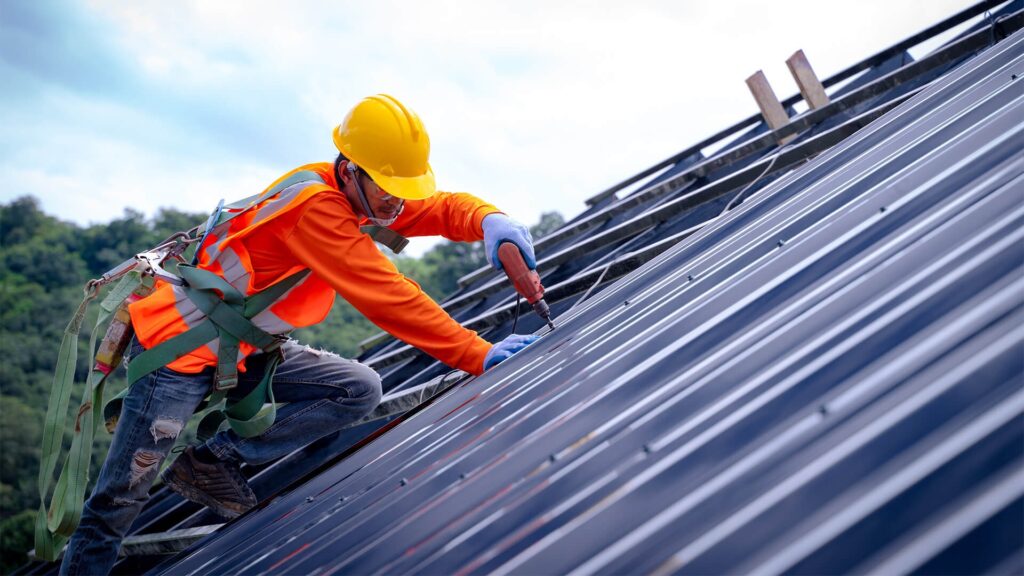
A well-maintained roof helps protect your home from the elements, maintain structural integrity, and preserve property value. Long-term exposure to adverse weather conditions such intense sun, rain, and winds can cause damage. Homeowners may overlook small roof maintenance issues, which can result in costly repairs or premature replacement. This is where roof restoration is important to preserving the life of your roof and protecting against future damage.
Roof restoration restores your roof to its original condition by cleaning, repairing, and recoating, to ensure longevity. Restoring your roof is a cost-effective alternative to full replacement, providing a quick and affordable solution for current and future issues. This guide explains roof restoration, its benefits, and how it prevents long-term damage.
The Importance of Roof Restoration
Routine maintenance prolongs the life of your roof while avoiding expensive repairs or energy-efficient upgrades. Restoration protects your property from long-term damage caused by weather exposure by tackling small problems early and saving you money down the line. Some of the importance of roof restoration are mentioned below:
Extending Roof Lifespan
There are many benefits of roof restoration, one of which is the prolonged roof life. Over time, the elements of the earth and sky will take on roofing components, causing them to decay, spring leaks, or worse cause disastrous structural failures. Restoration strengthens these elements, preventing early degradation and ensuring that your roof sticks around for many years.
Preventing Costly Repairs
Minor roof problems can become significant if not addressed in a timely manner. Leaks can lead to water damage, mold growth, and altered structural integrity. Regular roof restoration lets experts spot minor flaws before they become costly repairs or replacements.
Enhancing Weather Resistance
Australia’s weather is tumultuous; blistering summers, torrential rain and gale-force winds year-round. Roof restoration will make your roof more resistant to these elements by making use of seals to stronger cracks and weak spots, and protective coatings against UV rays, moisture, and temperature fluctuation.
Improving Energy Efficiency
A newly restored roof serves as better insulation and provides energy efficiency. A damaged or ageing roof will let heat escape in the cold months and encourage heat absorption in the warmer months, which will mean paying higher energy bills. Restoration also involves resealing and repainting, which helps control indoor temperatures and limits the reliance on exorbitant heating and cooling
Key Steps in Roof Restoration
1. Roof Inspection and Assessment
The first step in the roof restoration process is, of course, a thorough inspection. It includes an Inspection And Assessment of your roof where professionals will check the roof to identify the areas where it is damaged, and where there are leaks loose tiles, or rusted metal sheets. This will assess how much work needs to be done to get the roof back.
2. Cleaning and Debris Removal
These include cleaning a roof to remove dirt, moss, lichen, and debris from a roof that builds up over time. Pressure washing is commonly used to clean surfaces before applying repairs and coatings. This measure prevents clogs in the gutters and enhances the aesthetic of the roof.
3. Repairing Damaged Sections
To restore roof performance, repair or replace cracked tiles, rusty metal, or damaged shingles. Taking care of minor pest problems now can save you from worsening damage, as well as ensure you have a strong roofline without leaks.
4. Resealing and Repointing
You should also carry out repointing and resealing as needed for tiled roofs. Repointing is the process of fixing the mortar in between roof tiles, and resealing gives an additional layer of defense to your roof against moisture and environmental elements. This helps keep the roof structurally sound and prevents leaks.
5. Applying Protective Coatings
Protective coatings provide a barrier to the elements, resisting water infiltration, UV rays, and corrosion. These coatings improve the durability of the roof, providing an extension to the life span of the roof and an aesthetic finish to improve the overall look of the property.
Common Causes of Roof Damage and How Restoration Helps
1. Weather Conditions
Harsh weather, such as torrential rainfall, gale winds, and long sun exposure, will wear roofing material. Having a roof restoration strengthens the roof’s resistance to these elements, minimizing the risk of leaks, cracks, and erosion.
2. Water Damage and Leaks
Water damage is perhaps the most prevalent roofing issue. Leaks can cause mould to grow, structures to weaken, and repairs to be costly. Restoration seals cracks, replaces damaged sections and ensures proper drainage to fill a leak.
3. Mould and Algae Growth
On roofs, moss, mould, and algae can form from moisture build-up. These growths may damage roofing materials, which could become a potential mechanism for collapse. Future growth of algae and mould is prevented by roof cleaning and roof coating applications.
4. Poor Maintenance
Some issues could be small, but they can be major damage if you do not consider regular roof maintenance. Roof restoration is a preventative measure that keeps up with maintenance, protecting against major damage and increasing the lifespan of the roof.
Signs That Your Roof Needs Restoration
There are various signs of a damaged or ageing roof that would indicate it may need restoration. Identifying these signs early will prevent expensive repairs and preserve your roof longer. The following are common signs that your roof might need restoration:
Visible Cracks or Damaged Tiles
If you observe cracked, broken, or missing tiles, it could be a sign that a roof restoration is needed. If left unaddressed, these issues can create leaks and additional structural damage.
Water Leaks or Stains on Ceilings
Water stains and damp patches or mould growing on ceilings and walls indicate a roof leak. Leaks can also get worse over time causing serious structural problems and problems in your interior.
Mould, Moss, or Algae Growth
Any moss, mould or algae growing on your roof is indicative of too much moisture being held on the roof for too long. Over time, these growths can weaken roofing materials and lead to degradation.
Sagging or Structural Weakness
If the roof bows down, or if it is getting some signs of structural instability, it is a sign that the roofing framework is likely to be compromised. Weak support beams, prolonged exposure to moisture, or an ageing structure may be the reason for this.
Increased Energy Bills
If energy costs skyrocket suddenly, it can indicate that the roof is poorly insulated. Damaged roofing materials can cause heat loss in winter and heat trapping in summer, impacting indoor comfort and energy efficiency.
Rusted or Deteriorated Metal Roofing
Restoration is necessary for metal roofs with rust, corrosion, or failing coatings. Rust can compromise the structure, causing leaks and more damage if not repaired in a timely fashion.
Loose or Blocked Gutters
Gutters are vital to redirecting rainwater away from the roof and home. Blocked, loose, or overflowing gutters can cause roof leaks and structural damage.
If you’ve observed any of these warning signs, you should contact a professional roofing specialist for a complete analysis. Mobilization of roof restoration can avoid further damage, save money as well as maintain the sustainability of your home.
Conclusion
It is best to seal up the roof for long-term use for the whole structure of the home, and this is called roof restoration. In essence, restoration not only protects you from future roof damage by solving small problems before they become large, but it also enhances your roof’s ability to resist severe weather, its energy efficiency, and its property value. Regular inspections, timely repairs, and protective coatings ensure your roof remains in top-notch condition, protecting your home for years to come.
Roof restoration is a smart investment for homeowners who want to protect their properties and increase their longevity, and taking steps now can prevent expensive repairs and unnecessary replacement down the line. A good roof also complements the aesthetics of your home, prolongs insulation, and makes for a more secure abode. So, whether your roof is starting to show early signs of wear or if it has experienced damage due to severe weather, professional restoration will keep it in peak condition so you can enjoy peace of mind and long-term financial savings.
FAQs About Roof Restoration
1. How often should a roof be restored?
Ans: Typically, you can restore a roof every 10-15 years to keep it in condition and avoid deterioration.
2. Is roof restoration better than roof replacement?
Ans: Restoring the roof is a budget-friendly solution instead of roof replacement. Although severely damaged roofs need replacement, restoration can prolong the life of a roof and do so at a fraction of the cost of replacement, therefore it is an option available for numerous homeowners.
3. How long does a roof restoration take?
Ans: The time required for a roof restoration varies based on the size of the roof and the level of damage that needs to be repaired. It generally takes 2-5 days to do so but can take longer depending on factors such as weather conditions and specific restoration needs.
4. Does roof restoration improve energy efficiency?
Ans: Indeed, roof restoration enhances energy efficiency by sealing leaks, improving insulation, and adding reflective coatings that reduce heat absorption, leading to lower energy bills.
5. Can roof restoration increase property value?
Ans: A properly maintained and restored roof improves the aesthetics and structure of a home, adding market and curb appeal.






